[79FT]: Building Things |
 |
Metal Pickles
Russian autumn tradition
| On: | Oct 07, 2014 |
| In: | [Blog] |
| Tags: | engine |
No posts for 1 month and 5 days! Holy cow.
That's all been eaten up by a couple projects. One of them ended up being a complete redraw of all airfoil sections on the lower wings on the Skybolt; and nothing to write about (no pretty pictures, very routine work). Just lots and lots of cleanup.
Another one... was me following an old Russian tradition.
You see, during long winter months Russians' desire for fruit and vegetables (and mushrooms) is satisfied with pickled everything. Cucumbers, tomatoes, cabbage, grape leaves, dill (!), apples, garlic, fish (haha :) ), and other things which I don't know English words for.
My genes are calling. It's fall, and I had to pickle me something.
It was.. a disassembled Lycoming for the Skybolt!
Some weeks ago, a gentleman posted on the Forum about him selling an O-360-A4M, all overhauled, yellowtagged, and such, by Superior; with higher compression pistons from ECI, with everything needed to put it together minus the sump and accessories, for a very attractive price.
Best part was, it was disassembled, so I am to get all the fun putting it together without the disassembling and sending parts out for overhaul (and well, paying for that too :)).
In short, it was a great deal.
The problem? Well, I will not need it for quite a while. 10 years maybe, if I go with the speed I'm currently going at.
I figured, assembling and pickling it after would be a bad proposition. A much better one would be to pickle it part by part.
As usual, started with a thread on the Biplane Forum.
At the end of the day, I ended up using three things.
- Phillips Anti-Rust Oil
- STP
- Cortec CorrShield VpCI-368

Phillips 20W-50 Anti-Rust Pickling Oil
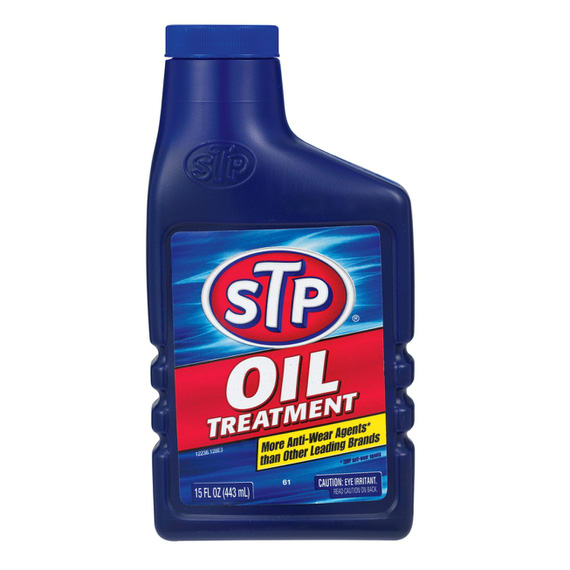
Good' Ol' STP

Cortec CorrShield VpCI-368
This latter substance is amazing. It's mineral spirits soluble, moisture displacing spray-on stuff that can protect up to 2 years in outside (!!!) storage. I'm storing the engine parts inside my house, so I figured it will do very good for a much bigger number of years.
It sprays on, and then dries over a couple days to consistency of candlewax. A bit sticky, but very tough. They claim it's scratch resistant.
Just in case I missed something or ended up scratching it off; I decided to also put a thick layer of Aeroshell grease on everything that's covered with CorrShield. Just in case.
And then...

It showed up!
For smaller pieces, I first wanted to put them in sealed sandwich bags, with some STP / Oil 50-50 mix, and squeeze all the air out.
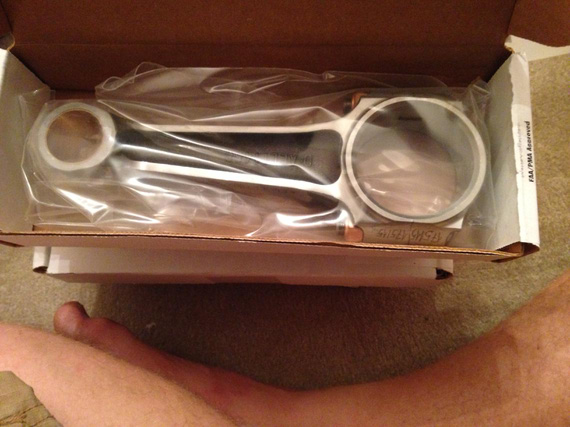
New connecting rod
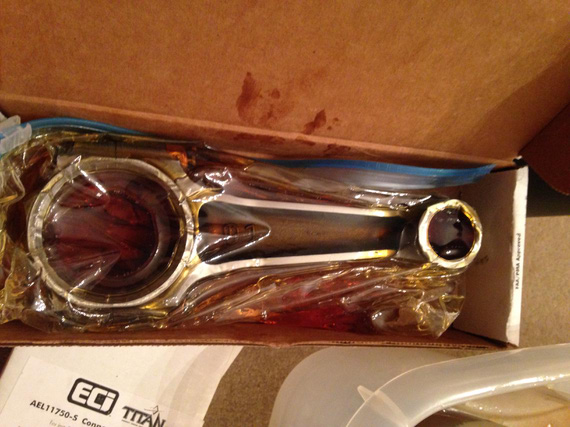
Now in the baggie with STP/Oil Mix

Gears and bits

.. all bagged up
But after them sitting like that for a couple days, I didn't like how all the oil drained to the bottom of the baggies. So instead, I submerged everything in 2 oil/STP baths.

Piston pins, gears, rocker arms, misc accessory case things in oil/STP bath
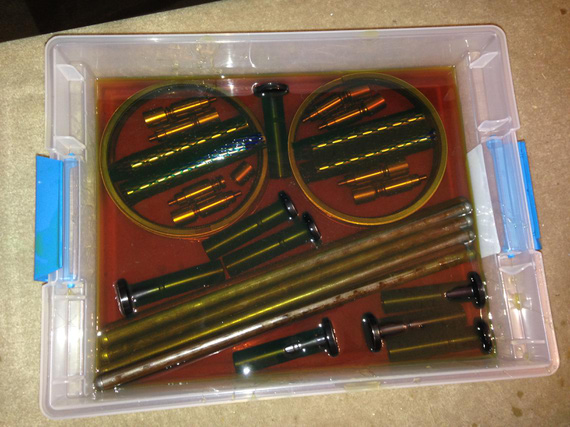
Pushrods, piston rings, tappets, etc in oil/STP bath
At this point, I ran out of oil and STP... And I had too much of CorrShield and grease -- and, after playing for some time with CorrShield and seeing how tough it is, I decided to use it on everything that didn't get into oil baths; even on smaller parts.

Crank

Cam

One of the jugs

Pistons
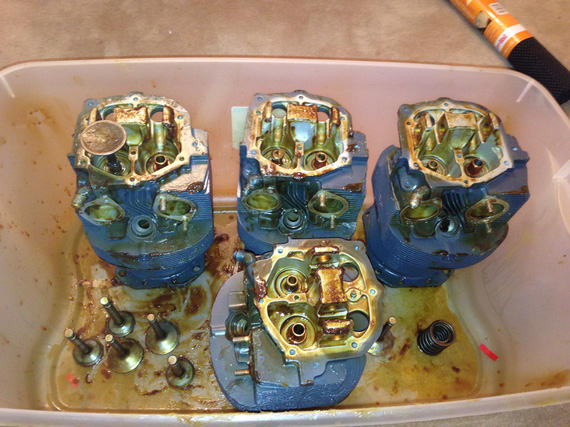
Jugs, right side up and tops CorrShielded and greased.
Some more small pieces stored "dry", covered in CorrShield and grease.

Connecting rods

Thru studs and pushrod tubes

Bearings, oil pump housing and minor pieces
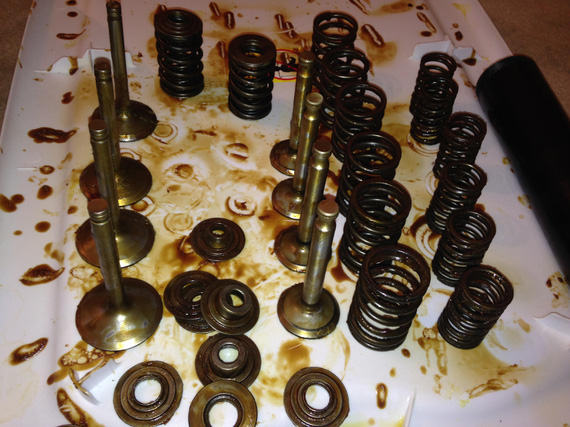
Valves.
This project took a couple weeks worth of evenings; and now my inner Russian is completely satisfied with his stash of pickles!
It's best to keep the pointed end going forward as much as possible.
Up ↑
Banging Sheet Metal
making bulges
| On: | Sep 03, 2014 |
| In: | [Misc] Cheetah |
| Tags: | sheet metal, cgr30, mechanicing, 9891U |
So on the Cheetah side, I am slowly ramping up for replacing all the engine gauges that I currently have on the panel with the CGR-30. I got it at Oshkosh, and finally, the box arrived a couple weeks ago.
Ain't she a beauty? Assembled on the bench for testing and familiarizing myself with it :)
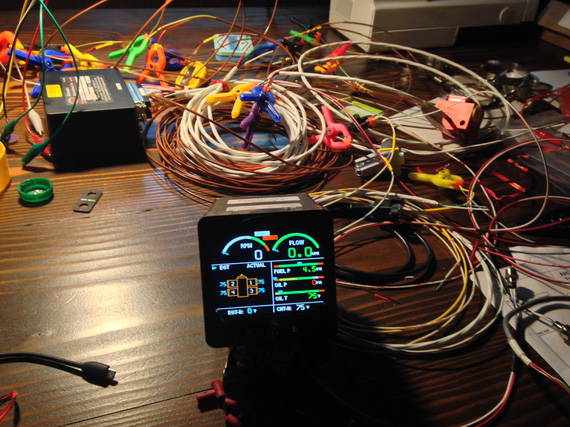
Ain't she a beauty?
Because of it, I will lose a few 2 1/4 inch round gauges, and I decided to make some covers for the panel, not to have unsightly holes in it.
Of course I could've bought them from Spruce or whatever, 5 bucks a pop, but if you know me, I would rather spend hours making something I can make. Besides, this is a nice first sheet metal exercise :). And, I wanted a nice domed bulge on each one of them. Just Flat wasn't enough.
So, I got to it.
First iteration was making a jig that would sandwich the sheet between two boards, with holes over and under the metal. Then, I would press a "piston" thru the holes using my vice as a press. Pictures are better than a thousand words.
Three piece jig + soon-to-be-'piston'. Oak boards sandwich the sheet between them. Ply plate has the "piston" and is used as a backing plate for it.
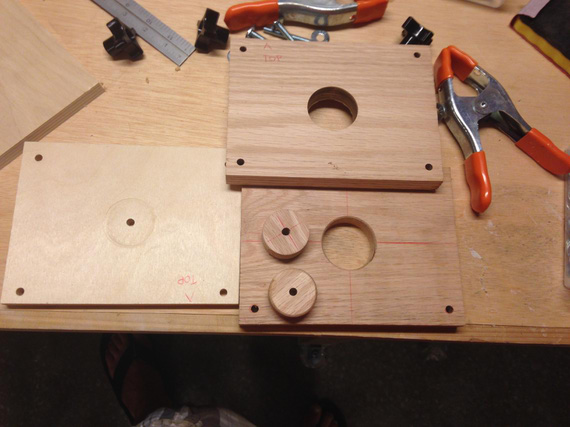
Jig pieces
That didn't work out. Vice jaws are not perfectly parallel, and the "piston" is not exactly the same diameter as the holes -- so it gets misaligned, even though there are four guiding bolts in the corners... Here's the jig assembled, and one of the first tries.
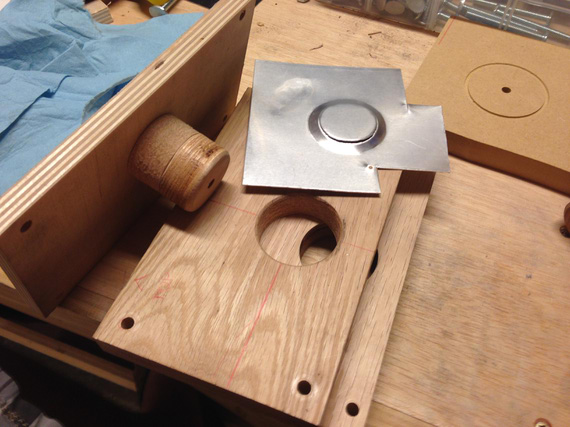
First try...
I think I tried it two or three times, with the same result.. no matter how much I tried to align the "piston", it would make a bit more pressure on one side of the jig than on the other, either resulting in a tear, or in an uneven "bulge".
Out of desperation, I took a piece of metal, laid it over one of the holes in the oak jig board, and started banging away - and was surprised! I was getting almost what I wanted, just not clean enough.
I tried sandwiching the metal between two plates and banging via the top hole - and made a fairly nice bulge! The edges weren't very clean, but I reasoned that if I opened the top hole up a bit more, that would give me access to the edge, and I will be able to bang on the edge a bit more, defining it better.
Ha! No. Same stuff.. I was able to make a fairly nice bulge, but the edge will be all "torn" and ugly.
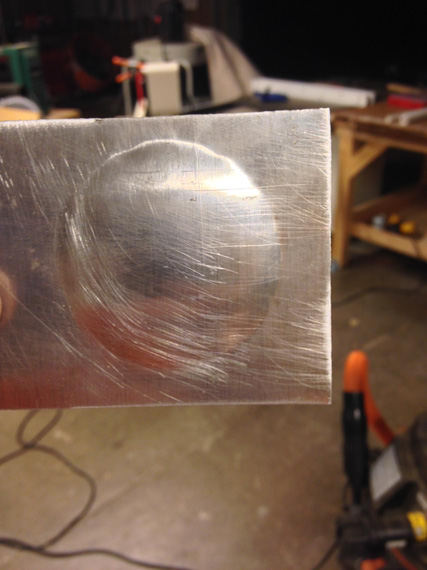
Bulge is there, but the edge is god awful
I also tried putting a profile on the bottom, "die" plate of the jig, with a very sharp edge and curvature under it.
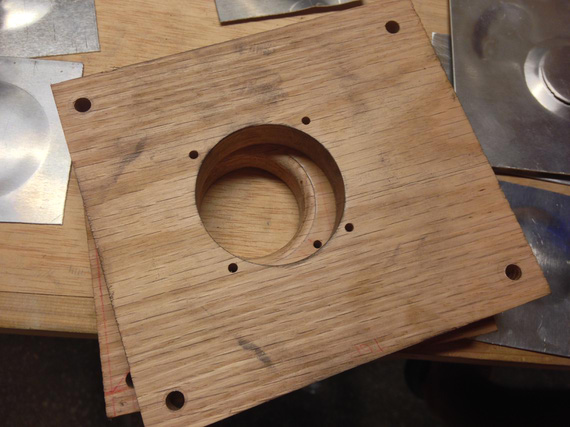
Second jig
No luck. I think I spent a couple hours, making over ten "bulges" and trying different hammering techniques...
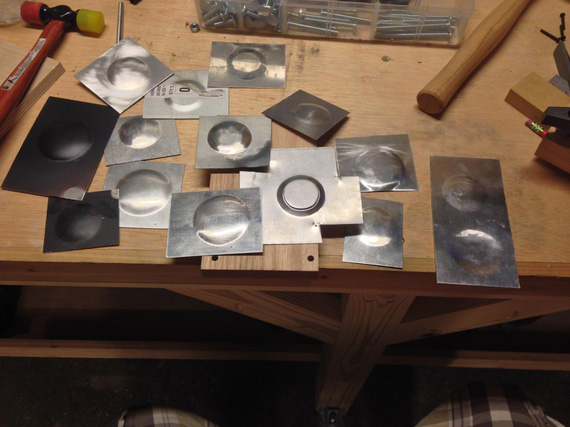
All those tries.

The Two Hammers
So I gave up, and emailed Bill Rose, the gentleman who gave me all the SolidWorks parts for standard HW, and, in general, helps me a bunch with my silly SWX and other questions, for advice.
Bill suggested using MDF for the jig instead of oak. Apparently, irregularities in wood grain would make it hard to define the edges uniformely. He also suggested using corking tools akin a big "chisel" on the edges to better define them.
..and.. it worked!
The third jig is ugly, but it works. Upper hole is enlarged just to get access to the edges (I didn't bother making the top hole concentric with the bottom or even round; there was no need).
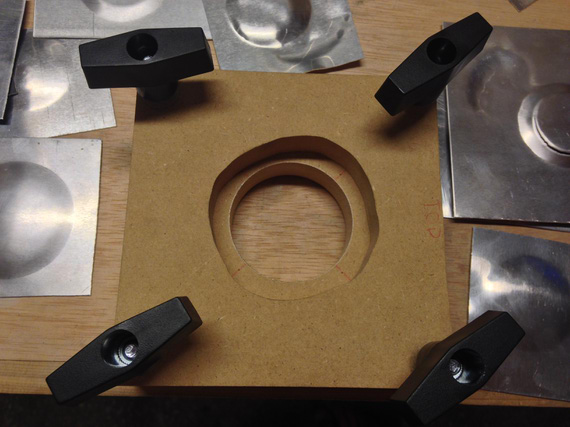
The third jig
I used the two-headed plastic/rubber hammer's rubber head as a corking tool, lightly hitting it with the plastic mallet, and having it slide from the edge into the center of the bulge.
This bulge still has some "orange peel" on it and needs to be smoothed out, but the edges are very well defined!
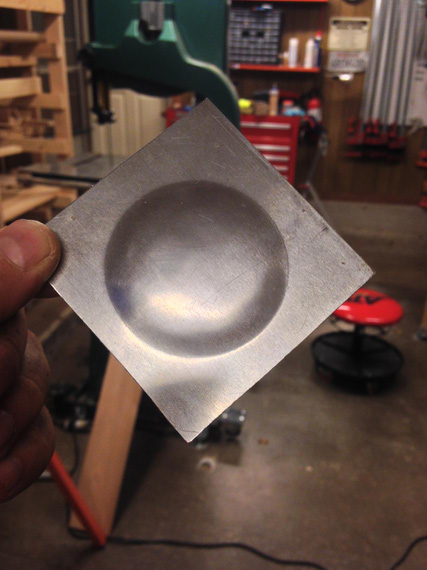
Check out those edges!
But of course, I screwed up again - the hole in the bottom, "die" plate of the jig, is of a wrong diameter (I used the wrong holesaw). But hey, at least I think I figured that technique out!
Good evening in the shop tonight :).
Why did God invent women when airplanes were so much fun?
Up ↑
Drag Wires, Aileron, et al
completing and refining
| On: | Sep 01, 2014 |
| In: | [Skybolt] Wings |
| Tags: | CAD, lower wings, ailerons |
Another week and a half. Did a ton of little things; each one of which took a ton of time, with seemingly little result... I guess, devil's in the details.
It's constant tweaking and tuning of things that takes a bunch of time. But, at this point, most of the rough things are in, and it's that tweaking and tuning that's left to do...
Oh well.
Drag Wires: done.
Finished all the drag wires. Initially I did an incorrect layout from the standpoint of which wire passes over which (or under which, depends on how you look at it). Apparently, I came across a definition of drag/anti-drag that's exactly the opposite of how the plans define them... Sigh.
Wires have to cross inside the drag wire blocks and inside the spar; so one has to go over and one under, like this (lots of transparency here):
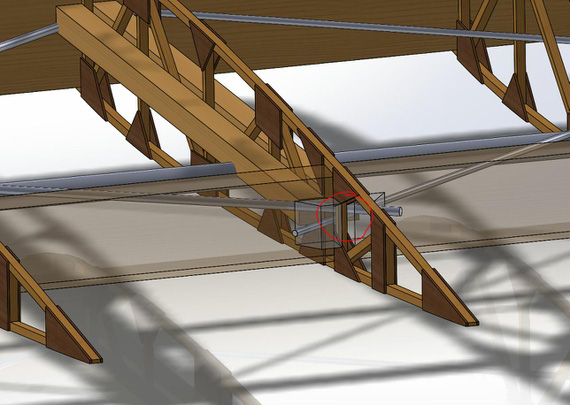
Drag/Anti Drag Wires Crossing
That's the pattern I did wrong; causing some interference with the bellcrank and heavy interference with rib diagonals.
Thanks to my original post on drag wire blocks interference in the aileron bay, and the picture Ward posted in that thread, I figured the wires pattern out. Switching it around made for much better clearance!
Also, my original problem with aileron interfering with the drag wire blocks is apparently no problem at all - I'll just relieve them (rasp, file, sandpaper, whatever) to provide clearance.
So, here's what the wing looks like right now:
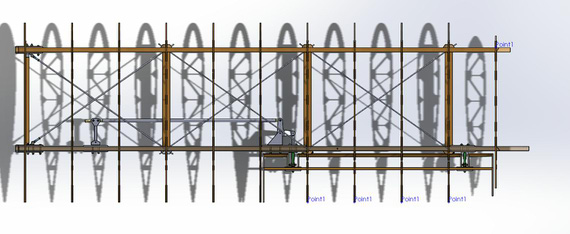
Latest wing with all the drag wires
Aileron Bay and Drag Wires
... and then, something I spent quite a number of hours on. You see, I want to sheet the inside of the aileron bay with curved piece of 1/16th plywood, supported on braces joining ends of the ribs together.
A few pictures below show the idea:

Aileron Bay Sheeting. Grain orientation is off, I know :)
This shows the support brace between ribs, just one for now.
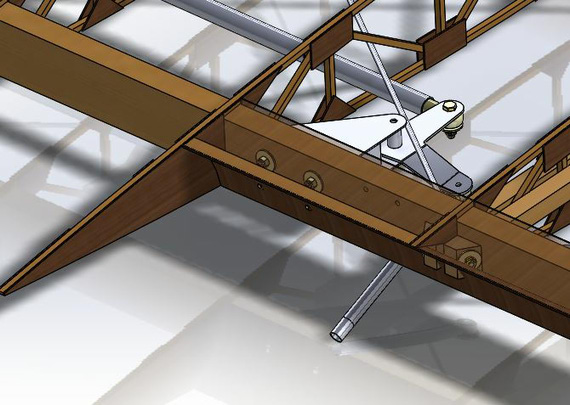
Aileron Bay Sheeting, showing the support brace.
This is all very rough. The problem though was this.
Here's how it looks from the wing tip side:

Aileron Well, looking from the tip, zoomed out
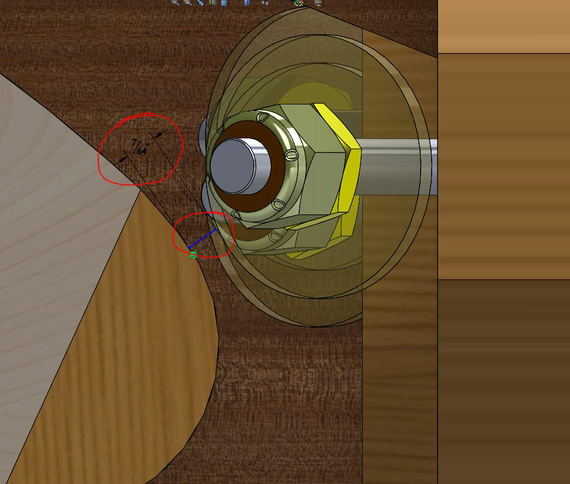
Aileron Well, zoomed in.
See that clearance??? 7/64ths between the aileron tip and the nut! So even before I started figuring out the best spline curve for that sheeting, it was obvious that it won't clear... 1/16th ply + 1/16th gap is already a 1/8th, or 8/64ths!
Asked the Biplane Forum folk in the same thread... And, separately, actually figured it out - it was suggested to use two thin jam nuts there instead of a thin + regular nyloc.
That cleared a lot of space up!
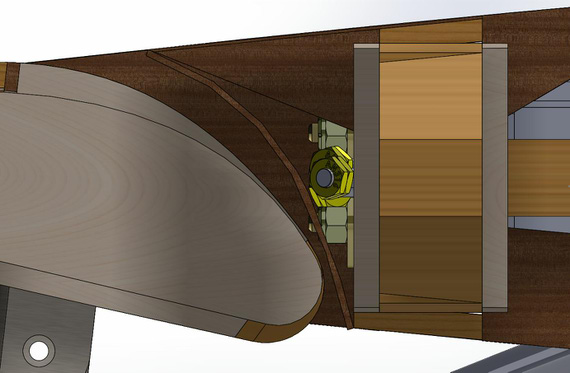
Finally, some clearance!
I was thinking about modifying the tails of the wing ribs in the bay area to support this sheeting.. But, even with thin jam nuts, the bay is still very tight. Given that I won't be able to build exactly to perfect dimensions, I finally decided not to bother, and just build in place (and then we'll see what clearance I really will be able to get :)
Backup plan? Have some drag wire hardware protrude into the bay, and sheeting be not "in front of it", but somewhat behind it (closer to the main wing spar). Something like this.
And with that, I moved on to
Cleaning a lot of things up
Added all the hardware to the aileron hinges. Cleaned up most of the compression plates (doublers) to go around the compression struts and drag wires.
Oh, and apparently, my aileron hinges were drawn a bit wrong (and had that unsightly early model of Fafnir rod end I have thrown together). Fixed that. Made them pretty green color to celebrate the occasion :).
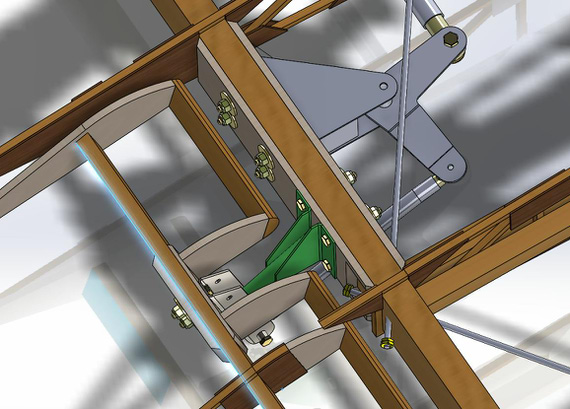
All pretty and correct hinges with HW

Compression plates relieved for the struts and drag wires
Interference
As I expected. Drag wires don't clear rib's diagonals in some places.
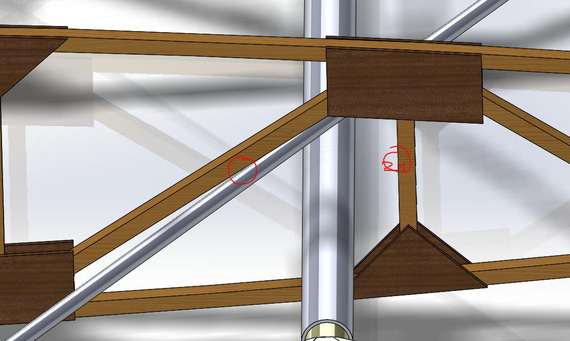
Station 24 vertical and diagonal interference.
Hale Wallace in his notes suggested to relocate station 24 vertical to 23 3/4, 1/4 inch forward (or "left" in the above picture). This will make the diagonal more steep, and clear the drag wires. I'll have to do that.
Another nasty. I was ready for this, and, sure enough, the bellcrank/idler pushrod doesn't clear the compression struts. The idler will have to be made lower; Steen bends them downward and I will see if I can avoid that by just moving it down a bit (and moving the idler arm down on it's bushing).
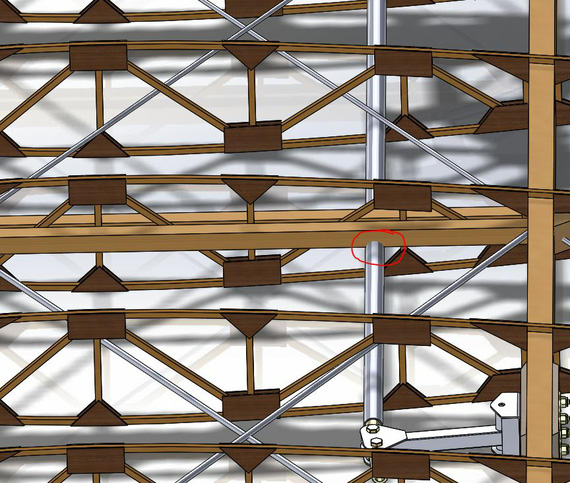
Pushrod not clearing compression struts.
Ribs
So, I started looking at relocating that vertical first.
My ribs' models are the first ones I did in Solid Works; and they suck. They are made off of sketches created from converted AutoCAD files, with lots of ugly things in them. They are practically unmodifiable. Back then I thought it was easier to draw things in AutoCAD and import them to SWX - oh, what an idiot I was :).
Also, while looking at things, it became clear that they also are not sitting right on spars (not symmetrical to spars' center plane basically).
It feels like I will end up re-drawing them from scratch, and doing them as proper assemblies this time. We'll see.
It might well be that the problem I was having with aileron-to-other-ribs-alignment will go away, and no holes will need to be relocated...
It's annoying, but at this time I am so much better with SWX than back a year ago when I was doing ribs. Still, Le Sigh.
Aileron Tip Rib, Wing Tip Rib, and Tip Bow
I've been putting this off, since those tip ribs are not dimensioned on the plans, and aren't a standard airfoil. They're supposed to create a nice transition from the main wing panel into the tip bow, creating some nice curvature.
I had the wing tip rib drawn up approximately, just as a placeholder.
Yesterday, I did an approximate aileron tip rib as well. Cutting it out of the plan and super-imposing two patters on one another helped! Plans are off (dimensions marked on them are not matching the dimensions measured off of them), but at least they're off uniformly within one sheet; allowing me to do this. It shows what's where.

Tip Rib, cut out - finally, some physical work on the "plane"!
Well, for one, it became obvious that the top aileron skin on the leading edge will have to create a compound curve going to the tip rib.
Searching thru the Forum, and reading things showed that apparently it's not that big of a problem. Gradual gluing and lots of clamping pressure should solve that one. :)
And then, there's the overall tip rib shape.

Overall setup.
This is all very early with no "trimming cuts" made, obviously.
If you think about it, the aileron tip rib is supposed to be a bit "beefier" ("taller") than the wing tip rib. The tail of the aileron tip rib in the place where it's touching the bow should be 3/4 inches tall (so that it's flush with the bow).
All that will create nice smooth "flow" of curves from the last "full size" airfoil section (created by the wing rib and the aileron rib) into the tip ribs and tip bow.
So, first thing I'm not sure about is how good my tip rib (wing rib that is) is. I think the aileron tip rib should "play off" the wing tip rib's shape... In fact, if you lay a straightedge between the tip rib and the aileron rib with aileron positioned at 0 degree deflection, moving that straightedge should define the form of the aileron tip rib. I will do just that, later, lofting the surface that will "cut" the aileron tip rib out (and use a real straightedge with some sandpaper glued to it to shape the actual aileron's tip rib). I love it how CADing makes you think about these things!
But! That requires me to have a nice wing tip rib. Which I don't have. So to that task then, first.
Skybolt plans have the general outline and no grid on them. It's not a standard airfoil. Hmmm...
Last time I did it, I took dimensions off of plans. It turned out a bit off shape-wise if compared visually to the plans, so I tweaked it a bit. I still don't like that tip rib.
To the Firebolt!
Firebolt, by the way, is Skybolt, "improved" (and by that I mean added weight). Fuselage is a few inches longer, and hardware is all different; but basic wing design and overall things are the same. It makes it a great reference to read thru and see how things are done there.
Firebolt's wing tip rib is located at the same station as Skybolt's. That gives me some hope :).
Firebolt plans are also off (print dimensions not matching actual on sheets), but at least they have the grid -- amount of error accumulated over 1 inch of measurment hopefully is negligible. We'll have to see.
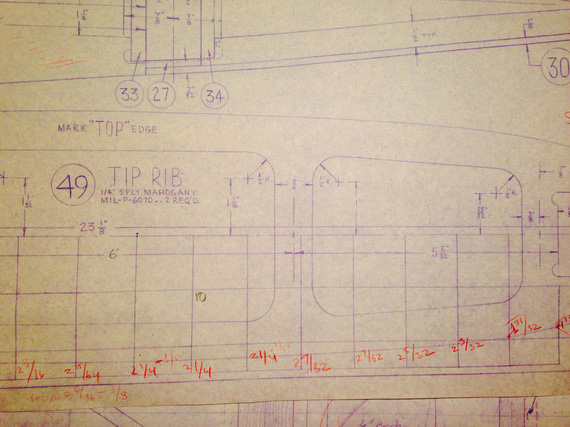
Dimensioning the Firebolt plans
And after going thru about half of that dimensioning, I decided that it's actually time to write this B-Log post, and take a break :).
I'll be bending some more sheet metal tomorrow. Post on that coming up!
You can land anywhere once.
Up ↑
SolidWorks Models
commonly used items
| On: | Aug 28, 2014 |
| In: | [Blog] |
| Tags: | tools, software, website, SWX |
Thanks to Bill Rose of the Biplane Forum fame, I have a lot of SolidWorks models of various hardware and other common airplane things.
I just recently have set up a page where you can grab all of them. Models are hosted on GitHub, so you will always get the most recent version.
The page is going to be linked in the Resources menu on the left. Click here to go straight to it.
Enjoy!
It is said that two wrongs do not make a right, but two Wrights do make an aeroplane.
Up ↑
Drag and Anti Drag Wires
the beginnings
| On: | Aug 21, 2014 |
| In: | [Skybolt] Wings |
| Tags: | CAD, lower wings |
Past few CAD sessions were drag wires and compression struts...
Typical wire blocks look like this:
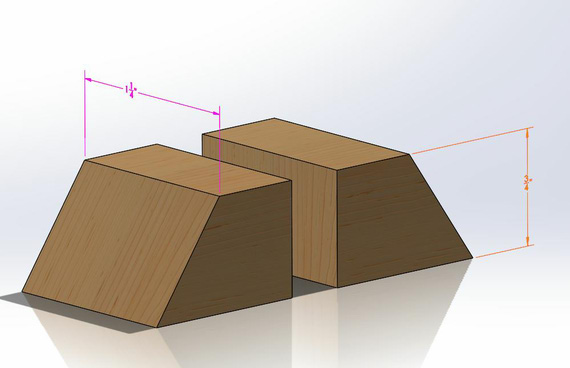
Drag / Anti-Drag Wire Block
One interesting thing is that those interfere with aileron's leading edge in the aileron bay if left as is...
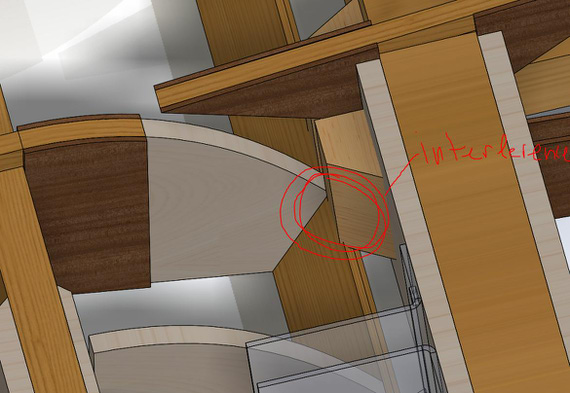
Block interference in the aileron bay
Again, asked guys on the Forum. Looks like just relieving them should work.
It's also clear that they interfere with the control system. Well, Ill have to adjust that when I finish the wires' models.
Meanwhile, added all the compression struts and working on the drag / anti-drag wire alignment and layout (they have to cross in the middle of wing bays, so I have to figure out what goes on top and what goes on the bottom). HFW did a good starting layout in his addendum to Plans, so going off of that for now.
Not much more to tell, so Ill just post two more pictures :).
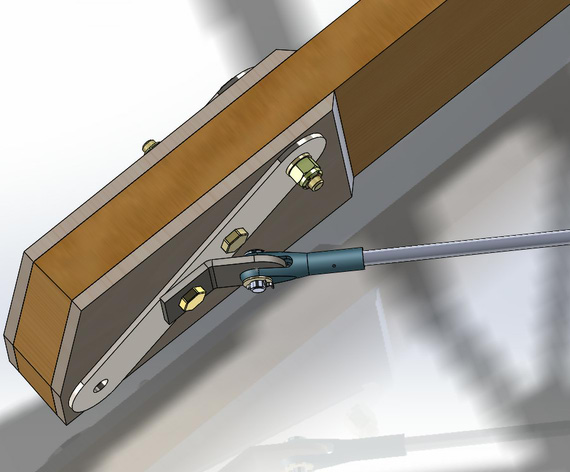
Drag / Anti-Drag Wires hardware
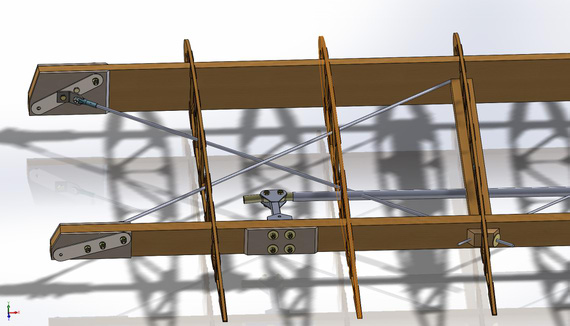
Drag / Anti-Drag Wires in the first wing bay. Second bay is being modeled
Navy pilots regards Air Force formation flying skills:
“Same way, same day.”
Up ↑
Ken Blackman's Story
... on landing
| On: | Aug 18, 2014 |
| In: | [Misc] Cheetah |
| Tags: | 9891U, flying, stories |
After I posted my story on removing the footstep to Grumman Gang mailing list, Ken Blackman of AirMods NW fame wrote me an email.. He recognized the plane, and apparently he flew it back in the 70s and had a great story to share... Here it is, below.
Ken Blackman's Story
...we were so desperate for airplanes we were picking up "drop-outs" from other dealers canceling orders when they came available and this plane was one (sans the little tanks) we bought while at the 1977 Dealer Convention. We has also agreed to purchase a '75 Traveler "Repo" from Grumman Credit that a dealer had faulted on. It was in Oklahoma City. Maynard took airlines to OKC to get the Traveler and I was going to fly the Cheetah to San Jose, drop it there, and fly the AA-5 on up to our facility at Everett, WA for needed mechanical work and sale prep. (We had a much better maintenance facility at my end of the operation) I was within a half hour of leaving when the delivery center paged me to the phone. It was Maynard and he was asking me to come to OKC and pick him up at the Traveler was a total piece of crap.
I flew there and we stayed overnight to get a got early take-off the next day. This was in January and there had just been a minor snow fall all through our intended route through Albuquerque and on west to California. The weather was clear the next day and winds were forecast to be light & variable. There was a big high pressure coming into the NM area so we figured we would make ABQ the first leg, refuel, and on to Prescott. The 37 gal. usable put us on a thin edge for the first leg but we figured we had close to VFR reserves. Tracking the VORs, measuring the distances and doing the math I was maintaining a steady 145 to 147 MPH and flying at the higher altitudes we were getting real good economy. From Tucumcari to the next VORTAC I calculated 146 MPH and the previous leg was 147. Marking the time from that one to the next one would require a certain number of minutes enroute so we continued along in smooth air. Maynard was sound asleep in the right seat. When the stopwatch showed we should be arriving at the next fix the "TO/FROM" didn't flip. I waited another couple of minutes, then started looking at my chart and the ground for references. (Lots of luck over the desert.) I woke Maynard up wrestling the chart and he asked what was going on. I explained we should have been at the check point 10 minutes ago but weren't. We both started looking for ground references and finally found two roads that intersected along our route line and identified we were still a good 25 miles from the VOR.
I called Flight Service and was connected to a briefer in ABQ. I explained our situation and he said there as a weather phenomenon occurring called a "Venturi Effect" I had never heard of. The high pressure area coming into the ABQ area was causing wind to flow into the lower pressure area we were in and, coming through the Sandia Gap east of ABQ, set up a headwind that dissipated just east of our position. We had a head wind of nearly 50 MPH! This definitely put Albuquerque out of range but retreating to Tucumcari would not work because we would lose the wind very soon and not have the push needed to get there. Santa Fe was possible as we would be flying about 80 degrees to the wind direction and it would dissipate before we were half way there but it was a stretch and they were having snow pellets and possible freezing rain in the forecast. Looking at the chart I found a dirt strip at Kline's Corners right along a freeway and cross road intersection. It was within our range so we headed for it. Arriving at the intersection and identifying it we could only find a ragged old windsock on top of a collapsing building in the middle of a lot of snow. "NFY"
We flew low over the cross road but there were power and phone lines that would prevent landing on it. There was the freeway and an underpass where that cross road went over it. There was a Chevron gas station there with the on-ramp to the interstate and traffic was light. We made a low pass to check for obstacles and it was good for about a half mile past the on-ramp. We made a left hand downwind and tried to set up a landing but there were a couple of cars we were concerned about followed by a couple more that we didn't trust to not panic and run into us if we landed in front of them. We went around again and had a similar problem plus two cars were coming down the on-ramp. We were flying on the tank that read the most fuel and, about the time we turned downwind, the engine quit! Switched tanks and decided we were committed this time. There was a Semi just going under the overpass and another one a mile or so behind it. Trusting that the driver of the 2nd one would not run is over, we settled down to land about where the on ramp joined the freeway.
We taxied off the main lanes to the shoulder and turned 45 degrees to the left and shut down. The Trucker pulled his rig up to block anyone from hitting our plane and got out his flairs. "What'd ya do, run out of gas?" he asked. "Nope, but close. If you think you are going to run dry, for God's sake, land before you do!" I replied. About that time a state trooper came flying off the opposite set of freeway lanes, bounding across the dirt, snow covered median and blocked the right lane of the highway. He had picked up the CB call from the trucker. After explain our situation to him he asked if he should call a tow truck... "NO!!!" I asked if he could just block traffic back of the in-ramp and we would taxi it up to the gas station. He did and we did. (I had to zig-zag through the edge of road snow markers but made it fine.)
This was before EAA was working with MO-GAS and we didn't know how it would react to it. We decided to use the higher octane unleaded so stuffed a hose in each tank and filled it up. The cop blocked off the freeway again and one of the guys from the station drove his pickup to park under the power lines and turned on his flashers. We taxied back to the underpass to give us a little more runway I did a run-up only to have the engine run very rough. We thought the car gas might be causing this then realized we were about 7,000 ft, MSL, and full rich was not the correct procedure. Leaned it out half way and run-up was fine. Take off was long but we were well above the power lines and on our way to ABQ. The damned thing ran better, and burned a little less per hour with the car gas. We decided to park it in ABQ and get a good dinner and night's sleep before flying on the next day to San Jose.
We decided to leave the plane at RHV and I flew a used trade in 2 place on home. The owners of Bede Micro (Keith Henshaw and Rod (his partner)) were close friends of Maynard and had become so with me. They developed the Honda Turbo conversion for the BD-5 and stretched the fuselage. They had a facility to help people build their BD-5 kits with their tooling and fixtures and assistance. They were talking about getting a Grumman for their running around and bought '91U soon after it arrived.
There was a good article about Keith in Sport Aviation, I think the January or Feb. issue this year, about his achievements in supporting the BD aircraft and development of the Honda powered version. (He passed away last winter in his late '80s.)
Well, now you know the bit of history of your airplane that is not in the log books.
Ken
There are some flight instructors where the student is important, and there are some instructors where the instructor is important. Pick carefully.
Up ↑
Messing with Cheetah, Footstep and Friends
... all in TX summer
| On: | Aug 18, 2014 |
| In: | [Misc] Cheetah |
| Tags: | 9891U, flying, mechanicing |
Weekends are plane days now. I fly to my friend's hangar and mess with 91U, the Cheetah (I still need a name for her :) ).
This past few weeks Ive been doing little stuff here and there...
Cleaned up the nav lights lenses.
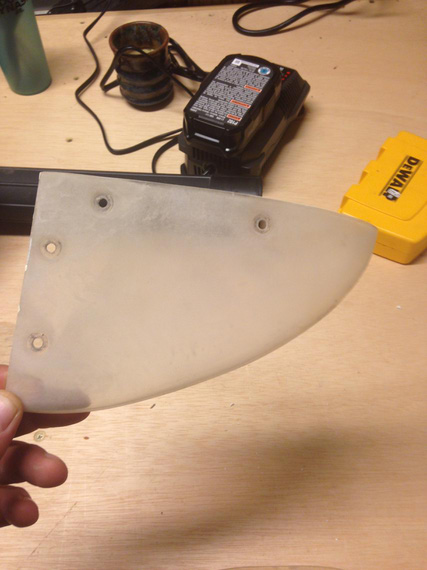
Before
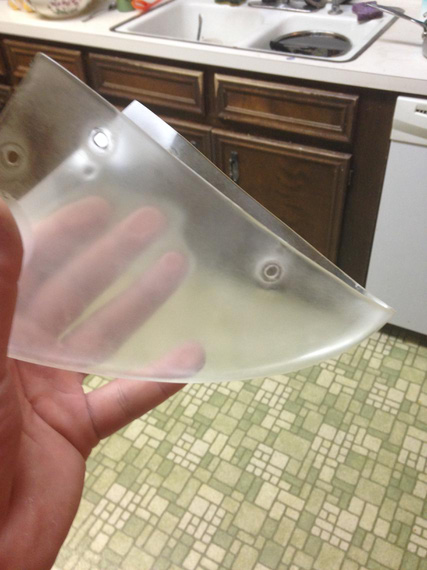
After
... they still look like crap, so I'll probably bite the bullet and buy a set of new ones.
Oh, and I need to make those vertical "shields" that cover the strobes away from the pilot's view.. Ill probably get the new lenses after I make those shields.
Started getting under the panel and cleaning things up, preparing for the CGR-30 Engine Monitor installation (I got one for a really good price at Oshkosh).
Taking the glareshield off, found this:

All dead defroster SCAT tubing
I'll need to replace all that...
Started taking the old gages off and thinking about where Im gonna put what.
I'll need to make some plugs for the holes emptied.
Right now, I have analog and half-broken EGT (the selector switch is dead), analog CHT that's not hooked up to anything (wires are butted, and there are no probes installed). Those are going away. HOBBS is also going away. This is all being replaced with CGR-30, so I get a few empty holes and options to move gauges around. I'll probably move the clock and the vac suction gauge so that they're better visible.
Pictures will come later when the work is actually done :)
This last weekend started quite jolly with me putting in the engine grounding straps (didn't have them when I bought the plane).
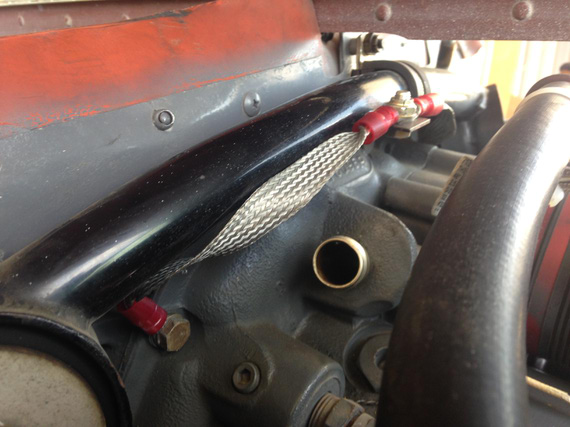
Grounding Strap 1

Grounding Strap 2
And then, I decided to deal with something special; the Foot Step. You see, I don't like them. I think they're ugly. So, I decided to remove them, and make a couple of fairings to cover the holes up and to replace the original plastic fairings.
Beej helped me (that means, "did it himself" rather ;) ) whip out the first test fairing.
And then, we needed to take off the steps.
The steps are bolted thru the fuse honeycomb with a couple of backing plates. There are two bolts, top is aluminum one (the thought is that it will shear before the bottom one and therefore prevent leverage and damage to sensitive fuse sidewall honeycomb). I believe AG-5s (later Grummans) replaced them with steel bolts; and people had some serious honeycomb crushing issues because of that.
Aaanyway. The bolts come from the inboard side, thru the streamlined tubing of the footstep and a couple bushings, and fasten themselves to the nutplates riveted to the other side of the footstep. Here's the schematic from the Parts Manual.

Footstep Schematic
There are a couple more bushings inside the streamlined tubing that aren't shown...
Also, the footstep sits in the wing root. You can kinda get access to the bottom nutplate if you take the fairing off. The top is right in the center of the wing root. And wing roots on Grummans are not fairings. I don't know how to remove one without pulling the whole wing (and Im not quite ready to do that yet...).
So anyway, happy me, I undo the rear seats and the cover that covers all the business under them, take the wrench, "assume the position" and start undoing the bolts. The first thing that happens is the rivets holding nutplates snap off.
So now, I am having Beej, not a small guy at all, under the plane on a creeper, holding the nutplates. We did the bottom one fast, the top one is a pain in the ass because it's, like I said, in the wing root. Had to take the flaps torque tube inspection plate off to get to it, and even then only could hold it with fingers.. the torque tube is getting in the way, you can't get any tools in there.
I should also mention that the bolts sit right under the back seat framing that holds the seat, and I can't even see the bolts I'm undoing without an inspection mirror. Gladly, not much there, so I've found them easily.
So, we undid the bolts.
Hehe. Now, to getting them out...
We were able to tap the bottom bolt out fairly easily. Well, it's right there under the footstep fairing, so that wasn't a problem.
The top bolt is the whole other story...
You see, the bushing inside the streamlined tube is steel. And the bolt is aluminum. The Mother Nature decided to give me a practical lesson on dissimilar metal corrosion.
So Saturday, as this was progressing and it was getting late (and time for Beej to go home), we tried pulling it, rotating it with a ratchet while pushing on the side. No joy.
Beej had to go. We had to disband.
I parked the plane in transient on Beej's field (I couldn't fly back with the footstep dangling like that on one bolt:)); and went home, determined to fix it. Had to have Dash pick me up...
Talked with Ben for over an hour.. Got a lot of good advice. "Heat it up". "Liquid Wrench". "Die Grinder".
Furnished a whole bunch of various tools. Some of them will probably scare some aircraft mechanics :)
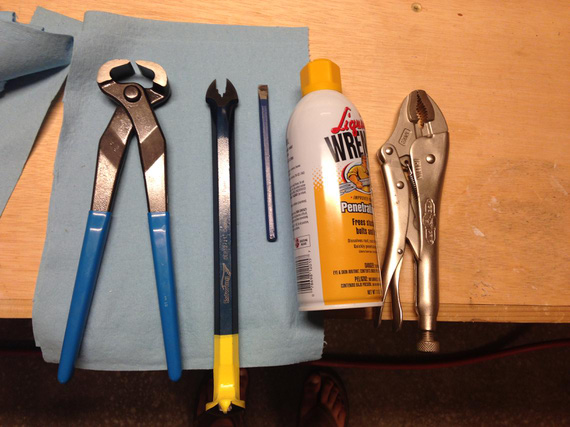
The Tools To Pull That Bolt
Note the pry-bar notch enlarged to take an AN5 bolt. I also custom-beveled the cold chisel to give it a sharper angle (hoping I'll be able to get it under the bolt head).
Sunday.
Put a bunch of Liquid Wrench on that bolt. Tried the chisel - nothing.
Did I mention that I couldn't see the bolt, only feel it? :)
Tried pulling, rotating with Vise Grips - nothing.
Soaked in more Liquid Wrench. Nothing.
Looking at it from the inspection mirror, it was clear that I could cut the head off if I could see it (I would never try that blind. Ever).
So, the mission became the "See The Bolt Head" one.
Bottom interior side panel, if came off, would reveal the bolt from the top and give me access.
Top interior side panel was blocking the bottom interior side panel.
Also, seatbelts and a little latch for the rear seat.
So, off went all of that.
Finally, I saw the sucker!
Tried pulling it out a bit more, now when I had a better access point.. no luck.
Oh well. To The Dremel!
The rest is...
History :)
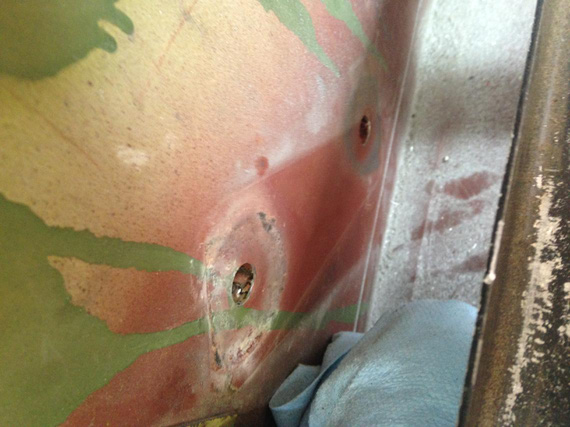
Holes after the bolts were out
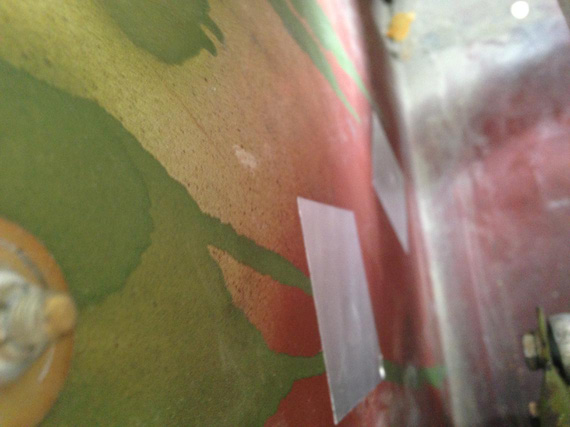
Patched with aluminum tape

The footstand, with headless bolt shank and the bushing

The nasty, nasty bolt shank with the bushing "welded" onto it by corrosion
But the Mother Nature wasn't done with me yet.
Buttoned the plane back up; pulled it in front of the hangar, and took Beej to lunch.
Came back.
Realized that I left the keys to my car in my wife's car parked at a terminal.
Had to walk there and back. A good mile.
Oh, did I mention the 100 degree Texas summer? :)
Coming back, needed to push the plane back. But no - the parking brake on one of the wheels was completely and utterly stuck.
My Cheetah is a 77, and uses mechanical parking brake. Ive heard before that they get stuck; but I always was able to get them unstuck by taking the brake off and tapping on the pedals with my feet.
The way they work is there is a metal plate that has a hole thru which the brake cylinder's piston's shaft goes thru. There's a chain that pulls it up, making it eccentric with the shaft, which locks the shaft in place.
Well; apparently it got a little more hot while we ate, and that plate just didn't want to go down. Tapping the pedals while putting the brakes on and off didn't do anything.
Oh, did I mention that I would have fiddle with it, get out, try to push the plane back, fail, get back in, all in a 100 degree weather? Not fun.
Finally, gave up and "assumed the position" again. That's when you dive backwards under the panel with feet hanging out of the airplane.
Wiggling it for a minute or so finally yielded a loud snap, and it was unstuck.
Phew.
Flight back home was uneventful :).
Bonus pictures:

In flight, looking back over Downtown Austin (I risked my phone taking that!)

Skybolt: "Are you talking to me!?" Cheetah: "No, are you talking to me?!!!"
Lack of planning on your part does not constitute an emergency on mine.
Up ↑
Wings and Control System
done..! Well, almost
| On: | Aug 12, 2014 |
| In: | [Skybolt] Wings |
| Tags: | CAD, lower wings, ailerons, control system, fittings, fuselage |
Ahh.. Finally. One week for a business trip, nothing done. One week and three days for Oshkosh. Nothing done (or rather, other stuff done :) ). And many more hours of fighting Solid Works; I finally have something to log! :)
Incidence and Fittings: Finishing Up
First, the incidence. Last time, I was trying to figure out how to deal with vertical fittings having to align with spars angled at 1.5 degrees up (incidence). A good discussion on the Forum ensued, and I figured (aside from me having to buy a +/- .0001 Precision Axe), to drill the hole at 1.5 degree angle in the front fitting, and forget about the little gap that shows up there, and weld the rear fitting in place. So something like this (you're looking at the fitting pair from the side, the CL is the hole centerline).

A pair of fittings, with the hole drilled at an angle

Gap that shows up when fittings are vertical, and hole is at an angle.
Note to self: When building / finish welding, I might reconsider and bend the tops of that fitting 1.5 degrees back to make everything flush. I probably will.
Back to the Control System
Next item on the list was bellcrank-to-aileron pushrod, which is tricky. See, if it's straight, it doesn't clear all the hardware.

Pushrod is not clearing hardware if straight
So it had to be slightly bent to make the bellcrank side rod-end a bit more "horizontal", if you will, while not "horizontal" enough to hit the spar above.
This sounds easy; and probably is -- but tweaking splines, checking, re-checking and tweaking again while checking for full range of aileron's motion took up most of the time here.. I think I spent a good 10 hours or so just tweaking that one pushrod... And finally, here it is -- notice a slight bend in it. Just a touch less bend and it hits the washer under the bellcrank side rod end, just a touch more, and it gets dangerously close to the spar.

Aileron pushrod, tweaked to fit
Finally, I was able to move the aileron linkage on the wing model and check the idler - bellcrank pushrod for ribs' verticals clearance. It clears! There's another clearance issue though - by the looks of it, it won't clear the compression struts (3/4 x 3/4 inch struts go in the middle of the ribs, forming wing bays along with drag/anti-drag wires) by the looks of it. So struts and wires it is, next, amongst other things..

Control system looking from the wing butt: won't clear the compression struts
Fitting Wings To the Fuse
For some reason, Solid Works gods decided to start hating me here. Remember the note about angled hole in the front wing fittings pair? Assuming that pair is mated to the fuse (lower longeron); front spar butt hole (ha.. ha ha.. haha..) mated to that angled hole in the fittings' pair should produce correct incidence; and dihedral can be set with wing spar centerline mated to, say, one of the fuselage's crossmember's centerlines, at required 1 degree angle? Ha! Yes; that worked -- but for some reason, would cause all kinds of shenanigans the moment I would make the SWX assembly flexible (== allowing me to move control surfaces of the wing sub-assembly as a part of the overall assembly).
Yeah-right. -3 hours of my life until I gave up.
Instead, I made a virtual "jig" -- another sub-assembly containing planes at correct dihedral and incidence angles. Wing's "Top" plane would mate to the "wing" plane of the "jig"; latter ("wing" plane) would be at 1.5 degree incidence / 1 degree dihedral. That worked.
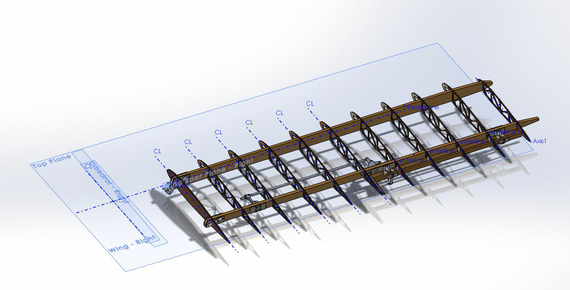
The virtual "jig" made of planes.

Dihedral of the lower right wing
That same "jig" assembly contains fittings mated to the wing spar -- and then, that "jig" subassembly is mated to the fuse via fittings - to - longerons mates.
That, for whatever reason, worked. After that, 10 more minutes of making one final pushrod connecting idler to Actuator Arm on the Torque Tube, and..
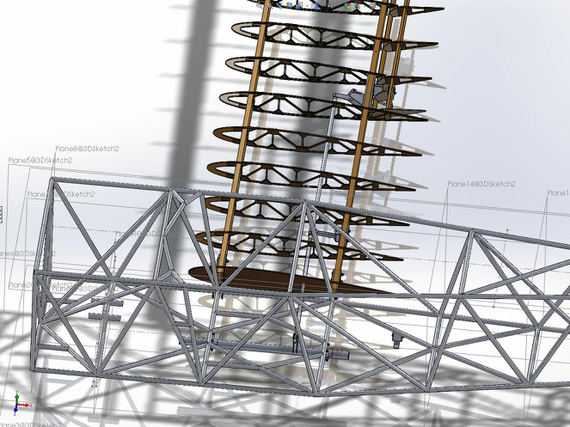
Control system all hooked up and working!
Happy me, making virtual airplane noises moving virtual torque tube moving virtual control system actuating virtual ailerons... Who says CAD isn't fun? :)
Now, back to those compression struts, only to find out that the pushrod does NOT clear... Le sigh.
The main thing is to take care of the main thing.
Up ↑
Rant 1: On Building
why's, and such...
| On: | Jul 14, 2014 |
| In: | [Blog] |
| Tags: | rant |
I decided not to post current progress on the aileron linkage.. Too much work into it, and too little to show. It was mostly cleanups, and modeling a few missing pushrods. Still need to put more things up until there's anything to talk about.
So instead, I present you...
The Rant
Originally posted as a reply to a hundred (or so) year old question of "why" in yet-another-thread-on-the-topic on the Forum.
Me and Ben; both Grumman fans and AA5-B aficionados, are sitting in a $100 burger place called Props at Ben's home field, chatting hangar talk. A really slick taildragger pulls up to the pump. "Oh; that's an RV-8. It's a homebuilt" - says Ben.
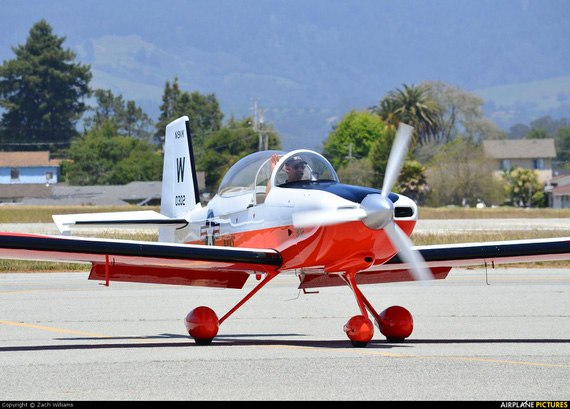
One of RV-8s based in Watsonville
I've heard about that some crazyfolk build planes in their garages before, but, being a fresh-off-the-rolls pilot with ~3 months of ticket behind me, never given it thought. My very first instructor's primary words were 'follow the procedure, checklist, certification, standards' (sidenote: I am not against following procedures, Im against instruction-without-explanation-of-why). Glad I ditched that guy 1/2 into my training... But you get the gist.
So, back to RVs. What a beautiful machine! Looks almost like a Grumman.. but slicker, newer, cleaner... And it's easy to build! And .. and ... and.
That times, I didn't have much background building stuff. I built some simple furniture with hand tools (think circular saw and trim router). I did some stuff in my mom's house back in Russia, primarily designing and building electrics and plumbing, when I was a teenager. I built office networks (15 1-inch holes in 3ft thick brick walls, anyone? Russian buildings are BIIG). I never really truly fabricated anything... Building computers was another one, but that one didn't involve any fabrication either, just making sure you put a cable right side in (anyone remember AT-style motherboard power connectors? "Black-To-Black", I will never forget ).
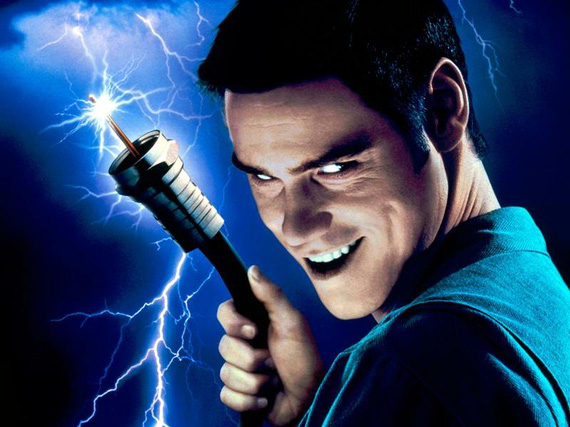
My experience level...
But I was always into tinkering with stuff.
So anyway, the whole idea of building a plane didn't scare me, and I was excited, but I wanted something with lots'a support, good kit, and such - because the idea of fabricating stuff scared me, at least somewhat. I also wanted something fast. The plan was, we move out of state (I was in CA back then, and that's the whole other story), I sell my share in my Tiger, add money, and build an RV. I really wanted an 8; but ended up deciding on a 10, because I like having more than one victim in my plane every now and then.
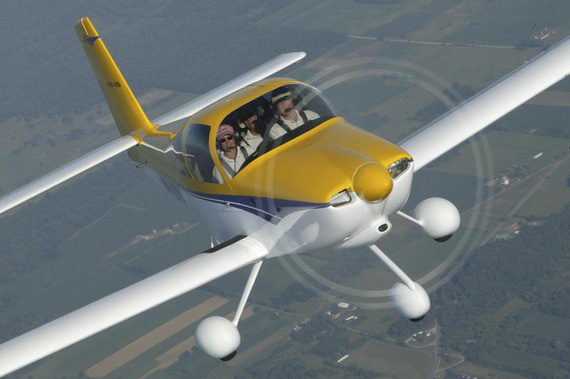
My dream plane.. back then.
I just wanted a Grumman Tiger, Improved; costs wouldn't allow me to get and some other things repulsed me from Cirrus, Columbia, and a-likes.
I was on Van's forums, reading technical details, articles, and such.
I was studying intricacies of how to connect Dynons with a 430 and make it a certifiable IFR EFIS with GPS. I was almost about to start my IFR ticket training, BTW.
I was dead set.
And then, that same Ben got me a ride in a Stearman with his buddy Jerry. That guy never ever flew a nosewheel, BTW; that day I caught Ben convincing Jerry that he has to get in Ben's Tiger and learn nosewheel finally ("yeah.. it's the same as a Stearman.. just never wheel it!" - Ben was sagely saying to Jerry at Props), and then Ben went "Oh Fidot, that's great you're here - we gotta put you in a Stearman". And they did.
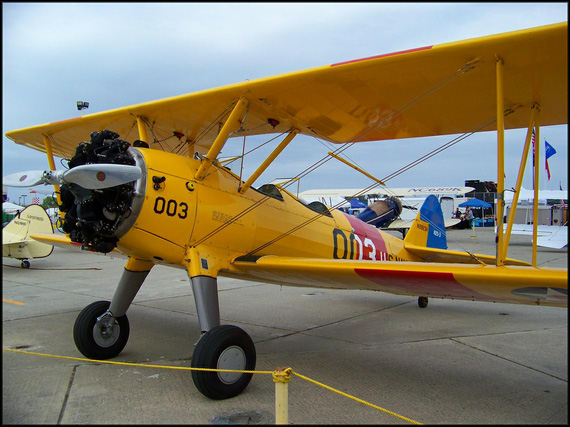
That Stearman
That day, in that first loop on the top side, my world was upside down, quite literally. I did IFR before; Drew, my second instructor, was a professional torturer (and great one at it; Im yet to see an instructor that comes even close to Drew). He made me do DME arks and shoot ILS approaches as a part of my VFR training, Because He Could (and we got that nasty marine layer in Oakland every now and then). I never did acro; not even spins though.
But That Loop... that was something completely out of a different world. The difference between never flying an airplane and flying a ratty Cessna 172 for the first time during the misleadingly cheap "demo flight" was probably less than the difference between having ~150 hours in nosepushers as a 'Private Pilot, ASEL', and doing a loop in a Stearman.
That caused a lot of thinking; a bunch of reading; and a ton of soul-searching.
As a result, my IFR money went into basic acro training (that I couldn't finish because I ended up moving out of state, after all, and there's no good acro schools around where I am right now).
As a result, RV-10 that flies dozens of pounds of electronics was ditched for a biplane. And open cockpit. And a 2 seater ('cause I like victims!!).
And most importantly, came a realization. You have to build an airplane to experience building an airplane. You can't build one 'cause you want one cheap, or you just Want One. Man, you can pick up an oldish Cub or a Citabria for about 30 grand; and a Yankee for about 25. Hell, you can pick up the homebuilt you want for less money than it's gonna cost you to build, if you're patient enough (and even if you have to wait for a year for one to pop up, you will still spend less time than putting together a kit (2-weeks-to-taxi et al excluded)).

Yeah.. Ill build THAT instead.
And 'cause I wanted to build to Build, I had to do it the right way. So, plans-built it was. I got the plans about a year and a half ago, and went thru mood swings between 'damm this is awesome' and 'damm Ill not fly for 10 years or will have to buy components or cut corners'.
There was, and is, a problem, and a hard one for me. Im addicted to flying. I did ~190 hours in the Tiger over a year and a half I owned that share in before moving out of state.
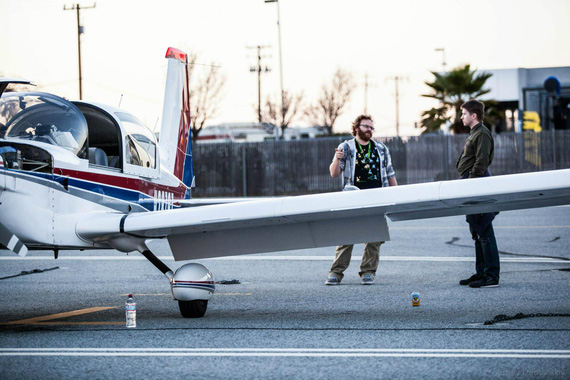
That Tiger; BTW...
But Im also addicted to building.
So I ended up deciding for myself that Im gonna do both. And I am. And I couldn't be happier. I don't need That Plane Im Building right now, I have something to fly. I decided not to rush, and just Take My Time; just make sure to not take multi-month breaks. 10 years, whatever. Im not in a rush.
Plus, my thinking is that works our real well with $$. You don't have to give tens of Ks of Presidents' Portraits to Vans or anyone else all at once. You pay as you go, and you build as you go. Got a bonus? Put it aside for an engine. Don't have one? Get some tubing and burn some holes in metal. Hey, I bet you can get cutoffs for dirt cheap or free at you local metal yard or whatever. Don't have any money? Do some reading, drawing, learning, and such. Hell, learn mechanical engineering. Aerodynamics. Structural analysis. 3D CAD (that's my current gig ). Hang out and help other folk in your chapter build things.

President's Portraits
Bottom line, Build to Build, and To Learn, not to Fly, or to Have an Airplane For Cheap.
Fi.
Rule one: No matter what else happens, fly the airplane.
Up ↑
An Unintended Trip
meet 9891U
| On: | Jul 07, 2014 |
| In: | [Misc] Cheetah |
| Tags: | 9891U, flying |
Heh. Multi-week moments of silence seem to start taking hold here. I haven't got much time to work on anything lately.
You see, I have finally decided that I am going to get myself something to fly while I work on the Bolt. I haven't flown for some months, and the withdrawal was settling in pretty badly.
Problem is, I moved to Texas about 8 months ago. Back where I lived before I used to own a 1/3 of a Grumman "N28797" Tiger; flying her at least once a week. I often would spend weekends bouncing between airports and hangar-flying in between hops, and took her to Oshkosh last year.
After moving, the only airplanes I was able to access were ratty Cherokees and Cessnas in a local flight school; and I could no longer go on my day-long hops just because it was too expensive. Writing $400 checks every time I went flying just... hurt, and I ended up not flying much.
So, a decision was made. I was to buy a plane.
A few strategically placed calls to my friends back in California immediately yielded a very good deal on a Grumman Cheetah (it had to be a Grumman of course) :).
Now, Cheetah is the same airframe as Tiger less 200 pounds of max gross and an O-320 instead of an O-360. Figuring that I now live on the right side of the Rockies and don't need to cross them much, my thinking is that Cheetah will actually suite my mission much better.
So, I hopped on a Winged Tubular Human Transporter, and was in CA a few hours later.
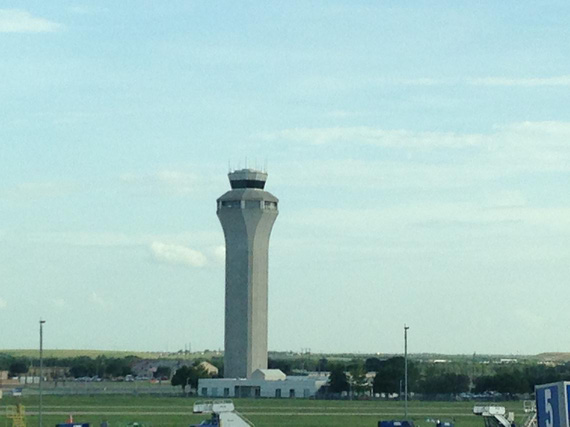
A mandatory airport shot. KAUS tower.
I was out of BFR; so we had to get that squared away first... No problem - AYA's Ben Rolfe, my good friend and Grumman mentor and fellow aficionado, told me that AYA was having a fly-in in Delano, and we went for it.
Oh man, I haven't flown a Grumman for a year! What a feeling it was to fly the airplane you truly know and love to fly, again.

Ben sharing bits of wisdom at Delano airport's restaurant

Grummans (not quite a mile of them :) )
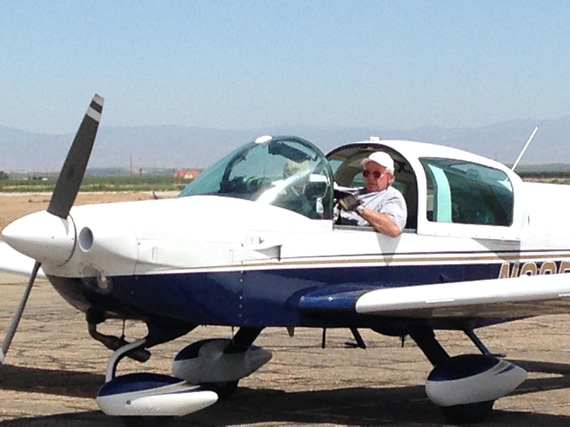
Stu's Tiger

The Bird of the Day: Ben's Tiger
..and finally, I meet the seller of my future plane at Abundant Air in Palo Alto. And the plane. 9891U!
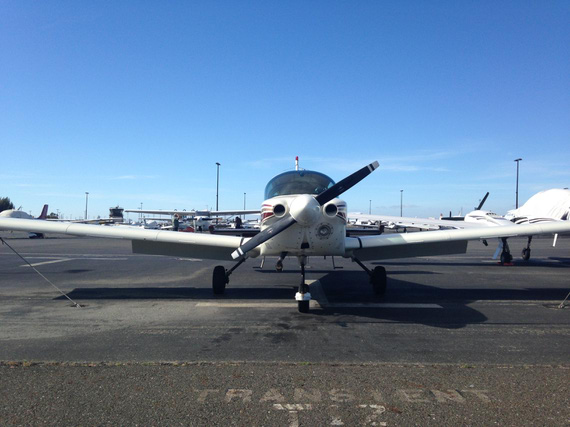
Meet the Cheetah!
LoPresti, Powerflow, and 160HP pistons STC. No wheelpants (will have to put those on, but okay for now). Basic panel. 400 hours on engine. Love it!
LeRoy loved her too. (LeRoy is my plush co-pilot. He likes Grumman Tigers the most, but liked this Cheetah a lot, especially 'cause of the colors. They got along real well!!!)
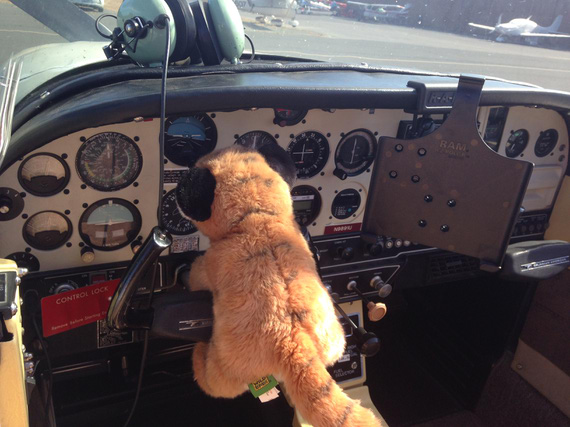
LeRoy getting acquainted
Over that week I was in CA after buying the plane, I have flew more than I have flew over 8 months in Texas.
I got checked out with Drew Kemp, my CFI and guru, gave some old friends a long-overdue ride over San Francisco, visited some more of the old friends in airports around CA, including the awesome Gary Vogt of AuCountry fame , and read lots of paperwork.
Funny thing: apparently one of the radios was stolen from this plane in 1995..
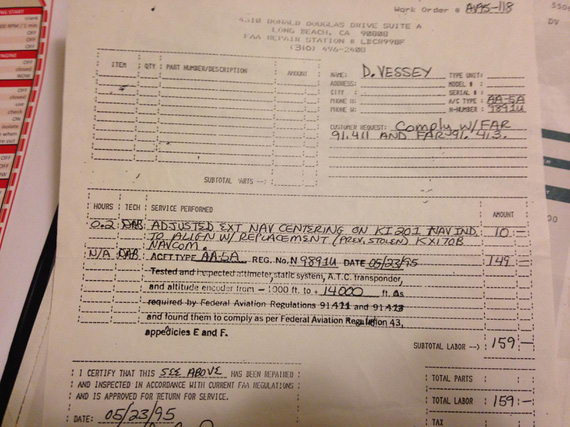
Stolen radio mentioned on this invoice
And finally, we were off to Texas!

Windmills in CA

LeRoy flying
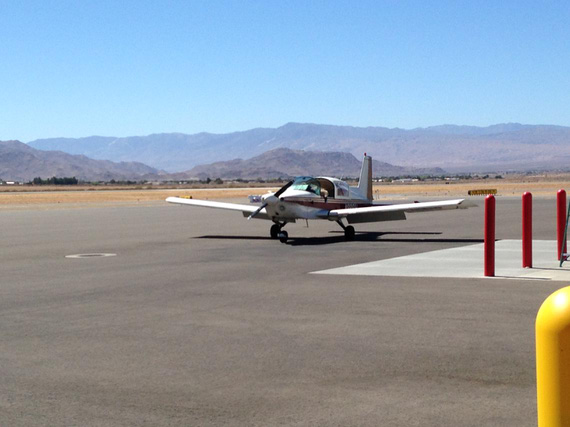
Refueling in Apple Valley
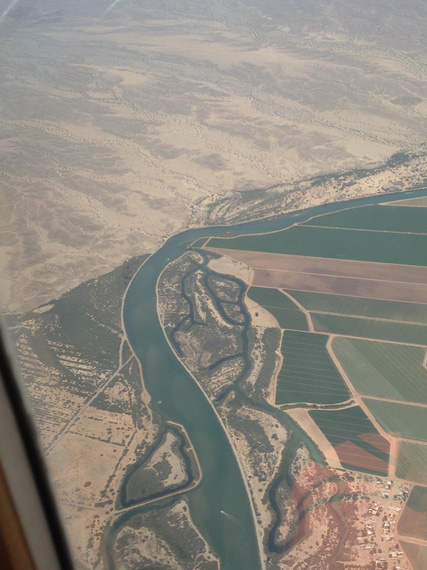
CA-AZ border, Colorado River
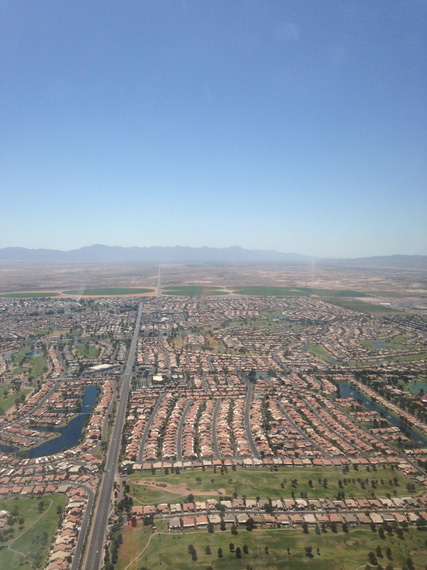
Buckeye: approaching Phoenix. Lunch time!
After lunch in Phoenix, we took off... My second in command Dash noticed high oil temps -- and I reduced the climb, leveling off finally at 5500. The oil just did not want to cool! Half way between Phoenix and Tuscon, the oil finally got a bit cooler, and I attempted climbing some more, but no joy. The moment I start climbing, the oil would hit redline. After trying that a couple times, we decided to bail in Tuscon, and spend a night there. Plan was to take off at 5:30 in the morning, and get past high terrain that starts after Tuscon early in the morning.
Cooling off in the FBO at Ryan Field near Tuscon, we started looking for options. It was Saturday, so renting a car didn't work out. I found a business card for Jeannie's Taxi in the FBO and called her up.
Jeannie's great! She came out immediately, and took us back over a great little road winding thru the Black Mountain and Old Tuscon; and agreed to pick us up at 4:30 in the morning!! We also had a great conversation pretty much about everything as we drove.
Next came Demming, New Mexico. A sad sight of an Arrow stuck on a runway at a weird angle warned that something was amiss. Luckily, Demming had two runways so I landed on another one. Noticed guys at the FBO already rolling in a golf cart to a now obviously belly-landed retractable Arrow, and decided to just wait.
The FBO guys rolled in a few minutes later. "What happened? Did he forget?" - "He forgot". Oh well. Gas-Undercarriage-Mixture-Prop...
One of the guys started fueling us. They have already lifted the Arrow, extended the landing gear, and rolled her into a spare hangar by the time we were leaving.
Fort Stockton was our last en-route stop; and three hours after that we were approaching San Marcos, my temporary home.
17 hours.
What a trip.
I am no longer planeless.
Amen.

Home
Think ahead of your airplane.
© Copyright "79FT". All rights reserved. Feel free to cite, but link back to the pages cited.
This website only shows how I did things in my various projects. These pages are for information and personal entertainment only and not to be construed as the only way, or even the perceived correct way of doing things. You are responsible for your own safety and techniques.